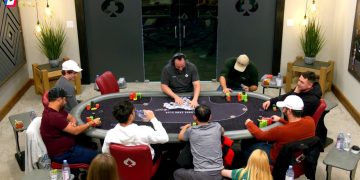If you want to win at poker games, you’ve got to start what’s in the hands of the other players. That’s where your decisions have to start, after all, and where your game is ultimately going to end. If you want to master poker and win Texas Hold’em poker tournaments, you’ve got to learn about something important – poker range.
What is a Poker Range?
Your poker range is the important information that you try to use to fill in the gaps of your knowledge, something that makes up the heart of your poker strategy. It’s the companion piece of putting players on a hand – it’s learning the basics of not just putting another player on a specific hand, but on a wide range of hands that you’ll have to sort down in time.
Most new poker players try to get to the point where they can put players on a hand – that is, to figure out exactly what they are doing based on what’s on the table. It’s a good strategy, but that’s just where you have to start.
If you want to play like the pros, you’re going to be looking at multiple hands in any given situation and figuring out how to deal with them all. That’s why it’s so important not to just know the full poker range that’s available to everyone at the table.
Let’s say you’re in a poker game and your opponent bets right out of the gate. From there, you know that the opponent probably has a good hand – maybe as high as a pair of Aces. As the game goes on, you’re going to calculate what his most likely hands are by looking at what’s on the table and how the opponent bets. This is how you find a poker range for an opponent.
If you want to learn about poker range and incorporate it into your own strategies, you’ll want to work on three things – figuring out your opponent’s poker range, generating the appearance of your own range for your opponents, and how to use the opponent’s assumptions to your own advantage.
Step One: Poker Range Analysis

You’re always going to start by looking at your opponent’s poker range. While the poker rules won’t let you look at the hand itself, you’ll be able to make some assumptions on the way that your opponent plays.
When the game first starts, there’s nothing to determine – your opponent’s hand could be literally any possible combination of two cards, less what you have in your own hand. You’ll get some more info, though, when play gets underway and people start betting. If the player starts off with a bet, he or she probably has a preferred hand – or at least something decent. If he checks, he probably doesn’t have a good pocket pair but he might have something worth building on.
Now your goal is to figure out where you stand in relation to that hand. If the opponent bet, do you have something that can beat a preferred hand? If so, how are you going to want to play in order to maximize the money you take home? These two questions are going to make up the heart of your poker range strategy going forward.
Once the flop happens, you’ll get to start working on narrowing down your range. Every card that comes out both opens up certain possibilities and closes others. Your goal is to figure out what’s the most likely option for your opponent based on how he or she acts at the table.
An awful lot of this is going to come down to the opponent’s actions in the pre-flop phase and as well as his actions immediately thereafter. If the opponent lets things ride, there’s a good chance that you’ll be looking at poker range that is an automatic win. If the opponent raises, though, take a closer look at the card – the range probably opened up into something that has a better than average chance of winning.
Your goal here isn’t to just assume the best or the worst of your opponent. Your goal is to look at the options that your opponent may have in front of him and make your decisions wisely. This means learning how to gather information about the cards of course, but it more important means learning how to gather information about how your opponent chooses to play.
Step Two: Dealing with Your Poker Range
As you might expect, you really do need to have a good idea of what’s going on in your own hand. This is not just so that you can throw your opponents onto a hand, but also so that you can make wise decisions about what to do next. It’s tough to build up an idea of your ranges because you are going to need to look at your own hand ranges in a few different lights.
A playable poker range tends to fall into one of three categories. The first is the raising range – the range where you think that you can make money. The second is the calling range – where you think you can win, but where you might have some trouble. The third is the re-raising ranging, in which you’re looking to pull in more money even when your opponent seems confident he or she will win.
Your job here is to work on building multiple ranges into your hand. You don’t want your opponents to figure out how you’re playing just based on how you bet, so you need to leave possibilities open all the time. This isn’t just about bluffing, either – it’s about your entire method of play even when you’ve got a sure thing.
Step Three: The Raising Poker Range

Let’s start by talking about what we mean when we’re working in that first category of poker ranges. You’re working on building up a raising hand, which is always a good idea because that’s how you make money. You’ll have to keep a host of things in mind, some of which can be contradictory.
As an example, you want to play with a good hand – that’s a given. At the same time, you can’t just look at how strong your hand is because you also have to keep your opponent’s strengths in mind. You’re looking to make choices that will allow you to make moves without being horribly obvious without setting yourself up for absolutely failure.
The way we solve this particular issue is with a sense of balance. Don’t just go with the assumption that your range is with the game winners, nor that it’s with the game losers. You’re looking to bet like you’re filling in gaps with connectors and suited cards. This gives you a lot of potential combinations with which you can work and a lot of data to make your opponent sift through in order to get a solid read on where you are.
The bad news here is that you still have a paralyzing number of potential choices when you play this way. The good news, though, is that your opponent is now in the same position. You can still work towards those big game winners, but playing out a fairly wide (while still reasonable) poker range is going to make you all the harder to predict.
A lot of things are going to change once the flop comes out, though. You’re going to need to develop your very own plans for dealing with the more random aspects of Texas Hold’Em poker, and you’re going to start looking for those fantastic little tips and tricks to help you make your decisions a little more easily.
This is where your knowledge of poker hands is going to come into play. Look at what’s on the board right now and think about the strength of your hand. How many potential hands are out there right now that can beat yours? How many can yours beat? If the number of the latter is higher than the former, you can start figuring out how to get into the zone of calling and re-raising.
Re-Raising and Calling Poker Ranges
We have to take things back to square one when we talk about re-raising and calling. These are all both things that you’re going to learn how to do in order to run the table, and you’re going to use at least some of the same skills as above. Again, this is all about not only building a range, but building a playstyle that’s just easier for your opponents to underestimate.
One of the big enemies here is, oddly enough consistency. If you’re only calling with particular hands, your opponent is going to figure it out every time. They’re going to raise against you and take every dime you have, because you’re going to be forced to act and you’re going to be playing from a place of absolute weakness. If you can’t take control, you simply cannot hope to win against even moderately skillful players.
So, what do you do? You play them instead of just playing your cards. Do a little work to make aggressive players re-raise when they don’t need to do so and make the cautious players fold when they would be better off betting. In short, you want to be in a position of controlling other players without them knowing exactly what you’re doing.
You want to keep your strategies close enough to your chest that your poker range will be entirely unknown until you get to a showdown. That’s going to mean sacrificing a hand or two during a tournament, but it’s going to be worth your while to do so.
It’s very important to make sure that you keep poker position in mind when you are dealing with any of these issues, though. There’s a huge difference between how you’re going to act as the big blind and how you’re going to act in the final betting position, so don’t try to play the same game two times in a row. This will open you up to many types of problems that knowing your ranges won’t solve.
Your job, if you choose to accept it, is to learn how and when to play hands that are speculative in nature. This means walking away from the very good advice of only playing those hands that are known winner and putting yourself in limbo just to prove to everyone else at the table that they cannot read you. It’s a little crazy and it’s dangerous, but it can also be one of the tools that allow you to play strong when you are ready to start winning.
Again, it’s a great idea to make sure that you keep some level of balance when you start to deal with poker ranges. You’ve got to know your opponents, know yourself, and more importantly know what you want others to think about how you are playing. It takes a great deal of work to learn how to read ranges and even more to pretend like your range is different than what you really have, so be prepared to do some hard work early on.
Final Thoughts
At the end of the day, learning about poker ranges is really a matter of figuring out how to read what’s going on at the table. You’ll pick this up in bits and pieces even if you don’t play regularly, but it pays to pay attention when it comes to this type of thing.
You need to not only use this information to figure out what your opponent is holding, but also to help your opponent think they’ve done the same to you. Poker can largely be a game of subterfuge between two high levels players, with both working to disguise their ranges and pierce the disguises of the other player at the same time. Read Poker Nuts to learn how to maximize profits by Knowing the Best Hand Possible.
Take some time to learn how to read range in a low-stakes environment when you can. Once you’ve mastered that, you can move on to tournaments and make it through the early rounds with relative ease. This is one skill that absolutely separates the great players from those who go home broke. See you at the WSOP!
♠ pokerjournal.org
Poker Range – FAQ
What does range mean in poker?
Range refers to the starting hands you will play. If you only play premium hands, you're a tight player. If you play all kinds of hands, you're a loose player.
What is range advantage in poker?
If you play a stronger range of hands compared to another player, then you're playing range advantage poker. A good player will realize that cracking hands aren't in the typical range.
What is the best poker range?
Poker isn't black and white. The best range depends on the circumstances, but if you want an excellent starting point, I recommend reading the Perfect Range.
What does GTO mean in poker?
GTO stands for game theory optimal. It supposedly means that you're always making the correct play, which is un-exploitable, but these are actually the easiest players to read if you know what you're doing.


















Discussion about this post